Pruning a Grapevine
The grapevine is a runner-plant in its natural form, which, if not pruned, will produce very small bunches of grapes. By pruning the vine correctly, it gets the desired shape and controls the quality as well as harvest and bunch size. Pruning can be used to manipulate vigour.
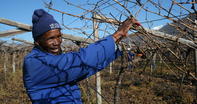
In the pruning process, the part of the shoot that has already had grapes is removed, as well as all unwanted shoots on the vine since bunches are formed only on an annual shoot on two years old wood. Pruning is done in the winter. The main purpose of pruning is to get and maintain the desired vine shape for the vineyard for as long as possible.
This way, the trellis system is optimally utilized. Secondly, the correct pruning ensures that a good quality crop is delivered. A good vine shape is important because it facilitates machining and optimal utilization of the trellis system and therefore a good use of sunlight and air. Grape bunches are also distributed more evenly.
In addition, increased bud fertility is obtained and it also ensures a good balance between the roots and shoot growth. The pruning method and the length of the bearer range from vineyard to vineyard, or it may also vary from cultivar to cultivar depending on the area and for which market the grapes are to be used.
Grapevine Pruning Methods
Spur pruning: a form of pruning whereby the canes/bearers are cut back to one or two buds. This method is mainly used on wine grapes. This short shoot containing the two buds are also called a spur. The cut is done above the basal bud, no higher than the second bud. Half-long pruning: a form of pruning whereby the vines are pruned to maintain half-long bearers.
It is usually used on table grapes or where a higher production of a specific cultivar is required. It can also be used to utilize the vigour of a vineyard by having more bud-bearing units per vine. Guyot pruning: it is the pruning of a vine to one or two canes with eight buds and each with a spur at the base for renewal the following season.
Guyot pruning is commonly used in the colder European countries in less fertile cultivars such as Cabernet, Pinot Noir and Sauvignon Blanc. Skilled pruners are required. Long pruning: a form of pruning whereby the bearers are left with 12-15 buds. It is mainly used on the Sultana variety. The advantage of this pruning is that it ensures good harvests in most table grape cultivars.
A big drawback is that a lot of manual labour is required. Mechanical pruning: is done by machines and the most commonly used method is horizontal and vertical blades. There are also other types of mechanization like high pressure scissors that can accelerate the cutting process considerably.
Bush vine pruning: it involves the same principles as spur or long pruning, but canes are deliberately cut to the outside bud. It is important to keep the centre of the vine open and a as rule a soccer ball should be able to fit into it.
Pruning Phases
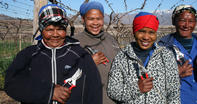
Hedging, also known as pre-pruning, is when the upper part of the canes is cut and pulled out of the wires. Hedging is done when at least 50% of the leaves have fallen and the canes are lignified (presence of bark-like tissue on canes). Pre-pruning facilitates the later pruning process and can be done mechanically or by untrained workers.
When using the long pruning method, hedging is not required. Preliminary or clean pruning is when all the shoots that are not used as bearers are removed. Preliminary pruning is done when at least 50% of the leaves have fallen and the canes are lignified. Short pruning or final pruning is the final phase of pruning when the shoots are cut back to the correct amount of buds.
Pruning Time
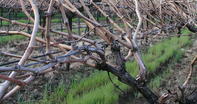
The time of pruning is important. Normally, pruning begins when all the vine’s leaves have fallen off; usually from early June. The rule is that early pruning promotes growth, while late pruning increases fertility and thus increases production. Bud burst can be delayed by two to three weeks and late pruning can therefore be used in areas where frost damage regularly occurs.
Late short pruning in August may result in increased bud burst. Vigorous vines can be pruned very early, just after harvest, while the leaves are still growing. This is done to reduce reserves and decrease growth in the next season. With some cultivars like Hanepoot, it is the ideal to do clean and short pruning simultaneously.
Handling of Cuttings
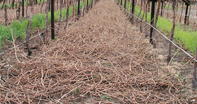
This aspect is very important for some producers, and the pruners are told beforehand where to leave the cuttings: Scattered in the middle of the row, where it is later cut into smaller pieces by a bush cutter to serve as mulch.
Cut into smaller pieces and sprinkled on the berm. The berm is the ground strip directly below the vine row. Thrown in every second row - usually a row where no cover crops are sown - to be later cut up by a bush cutter for mulch.
Pruning Wounds
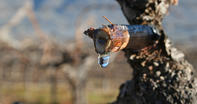
The wounds where the shoots are cut are treated after pruning against fungi. The handling of fungus control during pruning differs greatly from farm to farm, but it is very important never to prune on rainy days.
Examples of fungus management: Sterilize the scissors at the end of each row. Spray a fungicide solution directly after pruning on pruning wounds. Apply a wound sealant on pruning wounds larger than a 50 cent coin. Spray (Trichoderma) - a very good way to protect pruning wounds directly after pruning.
Care of Pruning Shears
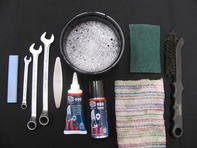
To get ready for the season and to extend the lifespan of a pruning shear always do the following: Clean the pruning shear blades after each use with a cotton face pad soaked in alcohol or hydrogen peroxide. Do a deep cleaning once per season by unscrewing the nut that holds the parts together and clean every part individually.
The spring must always have a good resilience and must also be kept clean and lightly oiled. Ensure the anvil is not damaged and that it is correctly sharpened. A pair of shears that are wrongly set will make you tired and damage the equipment.
Sharpen the blades. Sharpening at the right angles increases productivity and ensures clean cuts. The blades should be wiped cleaned regularly during pruning.
By Vinpro